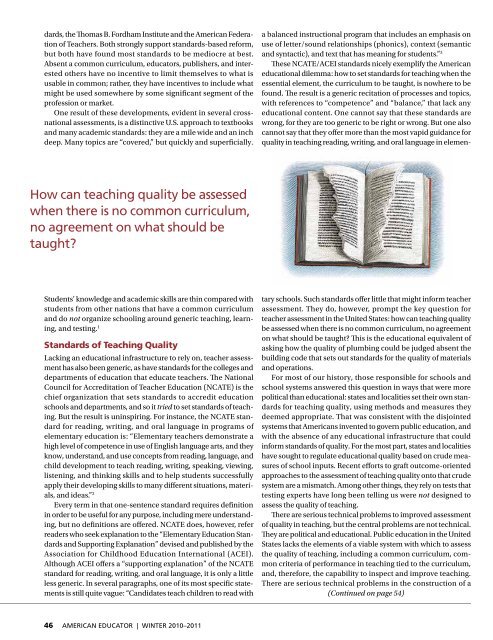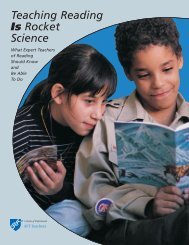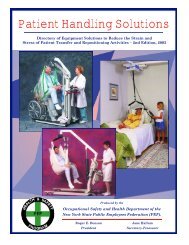American Educator, Winter 2010-11, Vol. 34, No. 4, AFT
American Educator, Winter 2010-11, Vol. 34, No. 4, AFT
American Educator, Winter 2010-11, Vol. 34, No. 4, AFT
You also want an ePaper? Increase the reach of your titles
YUMPU automatically turns print PDFs into web optimized ePapers that Google loves.
dards, the Th omas B. Fordham Institute and the <strong>American</strong> Federation<br />
of Teachers. Both strongly support standards-based reform,<br />
but both have found most standards to be mediocre at best.<br />
Absent a common curriculum, educators, publishers, and interested<br />
others have no incentive to limit themselves to what is<br />
usable in common; rather, they have incentives to include what<br />
might be used somewhere by some signifi cant segment of the<br />
profession or market.<br />
One result of these developments, evident in several crossnational<br />
assessments, is a distinctive U.S. approach to textbooks<br />
and many academic standards: they are a mile wide and an inch<br />
deep. Many topics are ‘‘covered,’’ but quickly and superfi cially.<br />
How can teaching quality be assessed<br />
when there is no common curriculum,<br />
no agreement on what should be<br />
taught?<br />
Students’ knowledge and academic skills are thin compared with<br />
students from other nations that have a common curriculum<br />
and do not organize schooling around generic teaching, learning,<br />
and testing. 1<br />
Standards of Teaching Quality<br />
Lacking an educational infrastructure to rely on, teacher assessment<br />
has also been generic, as have standards for the colleges and<br />
departments of education that educate teachers. Th e National<br />
Council for Accreditation of Teacher Education (NCATE) is the<br />
chief organization that sets standards to accredit education<br />
schools and departments, and so it tried to set standards of teaching.<br />
But the result is uninspiring. For instance, the NCATE standard<br />
for reading, writing, and oral language in programs of<br />
elementary education is: ‘‘Elementary teachers demonstrate a<br />
high level of competence in use of English language arts, and they<br />
know, understand, and use concepts from reading, language, and<br />
child development to teach reading, writing, speaking, viewing,<br />
listening, and thinking skills and to help students successfully<br />
apply their developing skills to many diff erent situations, materials,<br />
and ideas.’’ 2<br />
Every term in that one-sentence standard requires defi nition<br />
in order to be useful for any purpose, including mere understanding,<br />
but no defi nitions are off ered. NCATE does, however, refer<br />
readers who seek explanation to the “Elementary Education Standards<br />
and Supporting Explanation” devised and published by the<br />
Association for Childhood Education International (ACEI).<br />
Although ACEI off ers a ‘‘supporting explanation’’ of the NCATE<br />
standard for reading, writing, and oral language, it is only a little<br />
less generic. In several paragraphs, one of its most specifi c statements<br />
is still quite vague: “Candidates teach children to read with<br />
46 AMERICAN EDUCATOR | WINTER <strong>2010</strong>–20<strong>11</strong><br />
a balanced instructional program that includes an emphasis on<br />
use of letter/sound relationships (phonics), context (semantic<br />
and syntactic), and text that has meaning for students.” 3<br />
Th ese NCATE/ACEI standards nicely exemplify the <strong>American</strong><br />
educational dilemma: how to set standards for teaching when the<br />
essential element, the curriculum to be taught, is nowhere to be<br />
found. Th e result is a generic recitation of processes and topics,<br />
with references to ‘‘competence’’ and ‘‘balance,’’ that lack any<br />
educational content. One cannot say that these standards are<br />
wrong, for they are too generic to be right or wrong. But one also<br />
cannot say that they off er more than the most vapid guidance for<br />
quality in teaching reading, writing, and oral language in elemen-<br />
tary schools. Such standards off er little that might inform teacher<br />
assessment. They do, however, prompt the key question for<br />
teacher assessment in the United States: how can teaching quality<br />
be assessed when there is no common curriculum, no agreement<br />
on what should be taught? Th is is the educational equivalent of<br />
asking how the quality of plumbing could be judged absent the<br />
building code that sets out standards for the quality of materials<br />
and operations.<br />
For most of our history, those responsible for schools and<br />
school systems answered this question in ways that were more<br />
political than educational: states and localities set their own standards<br />
for teaching quality, using methods and measures they<br />
deemed appropriate. That was consistent with the disjointed<br />
systems that <strong>American</strong>s invented to govern public education, and<br />
with the absence of any educational infrastructure that could<br />
inform standards of quality. For the most part, states and localities<br />
have sought to regulate educational quality based on crude measures<br />
of school inputs. Recent eff orts to graft outcome-oriented<br />
approaches to the assessment of teaching quality onto that crude<br />
system are a mismatch. Among other things, they rely on tests that<br />
testing experts have long been telling us were not designed to<br />
assess the quality of teaching.<br />
Th ere are serious technical problems to improved assessment<br />
of quality in teaching, but the central problems are not technical.<br />
Th ey are political and educational. Public education in the United<br />
States lacks the elements of a viable system with which to assess<br />
the quality of teaching, including a common curriculum, common<br />
criteria of performance in teaching tied to the curriculum,<br />
and, therefore, the capability to inspect and improve teaching.<br />
There are serious technical problems in the construction of a<br />
(Continued on page 54)





